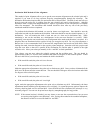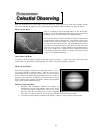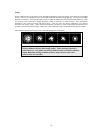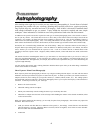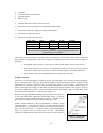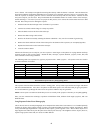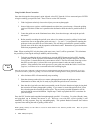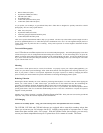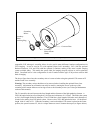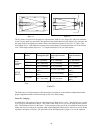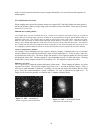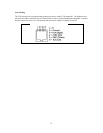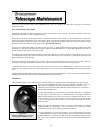45
There are several techniques for this type of photography, and the one chosen will determine the standard accessories
needed. The best method for long exposure deep sky astrophotography is with an off-axis guider. This device allows
you to photograph and guide through the telescope simultaneously. Celestron offers a very special and advanced off-
axis guider, called the Radial Guider (#94176). In addition, you will need a T-Ring to attach your camera to the Radial
Guider.
Other equipment needs include a guiding eyepiece. Unlike other forms of astrophotography which allows for fairly
loose guiding, prime focus requires meticulous guiding for long periods. To accomplish this you need a guiding ocular
with an illuminated reticle to monitor your guide star. For this purpose, Celestron offers the Micro Guide Eyepiece
(#94171) Here is a brief summary of the technique.
1. Polar align the telescope.
For more information on polar aligning, see the Polar Alignment section earlier in the
manual.
2. Remove all visual accessories.
3. Thread the Radial Guider onto your telescope.
4. Thread the T-Ring onto the Radial Guider.
5. Mount your camera body onto the T-Ring the same as you would any other lens.
6. Set the shutter speed to the "B" setting.
7. Focus the telescope on a star.
8. Center your subject in the field of your camera.
9. Find a suitable guide star in the telescope field. This can be the most time consuming process.
10. Open the shutter using a cable release.
11. Monitor your guide star for the duration of the exposure using the buttons on the hand controller to make the
needed corrections.
12. Close the camera's shutter.
Periodic Error Correction (PEC)
PEC for short, is a system that improves the tracking accuracy of the drive by reducing the number of user
corrections needed to keep a guide star centered in the eyepiece. PEC is designed to improve photographic
quality by reducing the amplitude of the worm errors. Using the PEC function is a three-step process.
First, the CGE needs to know the current position of its worm gear so that it has a reference when playing
back the recorded error. Next, you must guide for at least 8 minutes during which time the system records
the correction you make. (It takes the worm gear 8 minutes to make one complete revolution, hence the
need to guide for 8 minutes). This “teaches” the PEC chip the characteristics of the worm. The periodic
error of the worm gear drive will be stored in the PEC chip and used to correct periodic error. The last step
is to play back the corrections you made during the recording phase. Keep in mind, this feature is for
advanced astrophotography and still requires careful guiding since all telescope drives have some periodic
error.




